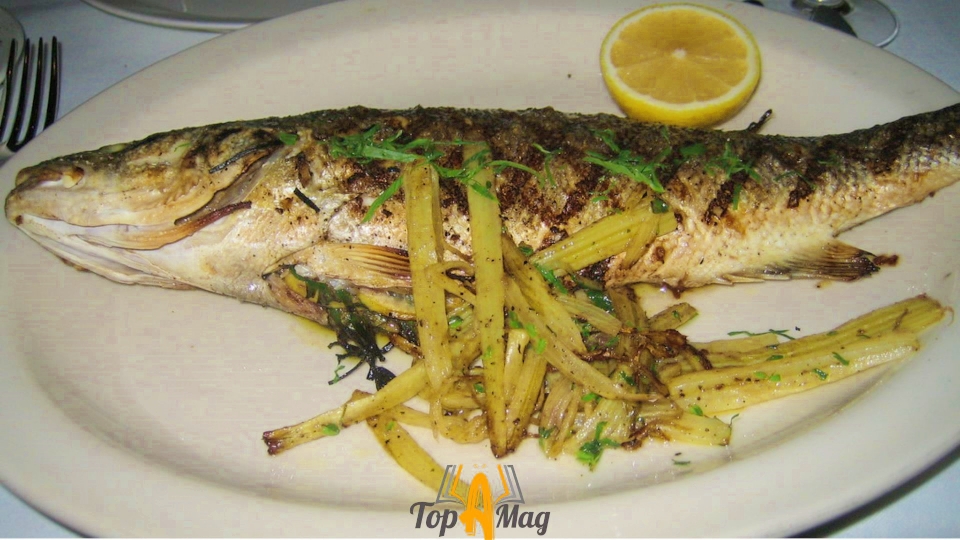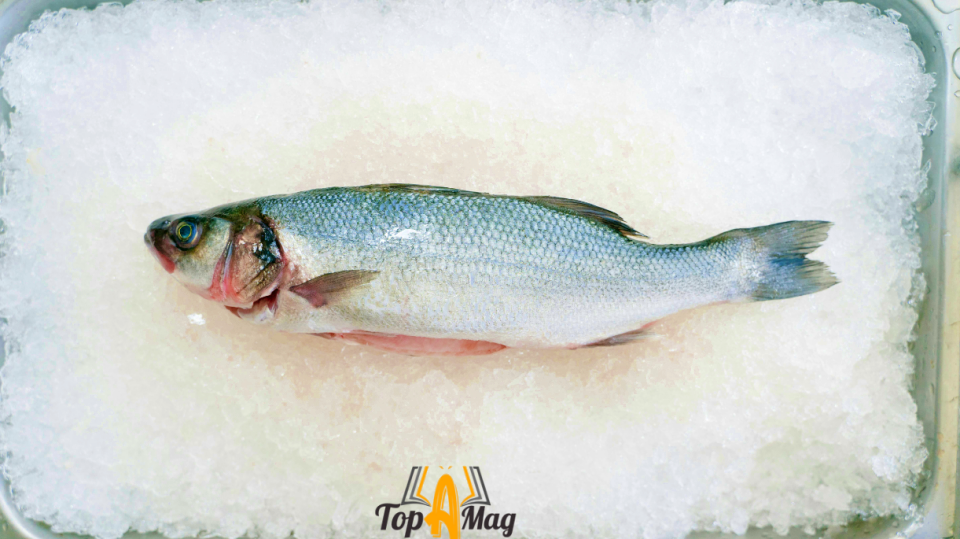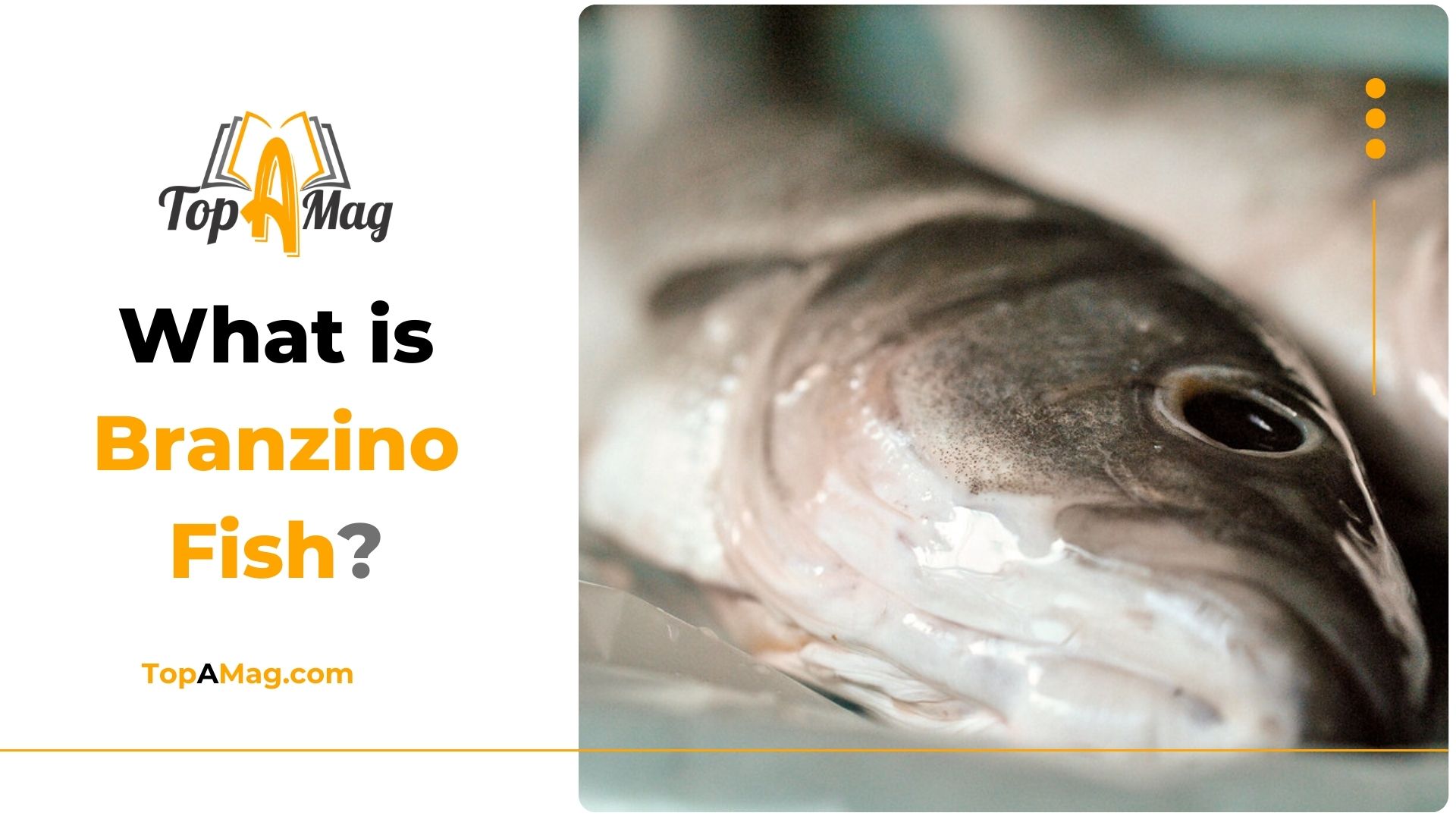When it comes to seafood, one name that frequently makes waves in culinary circles is Branzino fish. This Mediterranean marvel has gained significant popularity in kitchens worldwide, known for its delicate flavor, tender texture, and versatility in various cooking styles. But what exactly is Branzino? and why has it become such a sought-after fish? Let’s dive into the rich history, culinary uses, nutritional benefits, and more about this fascinating fish from this Guide by The Top A Mag Team.
Key Takeaways:
- Branzino fish is a Mediterranean white fish which is known for its delicate taste and gentle texture.
- It is rich in omega-3 fatty acids, vitamin D, and protein, offering numerous health benefits.
- You can grill, bake, steam, or serve Branzino Fish raw, and make it a versatile ingredient in various cuisines.
- Sustainable aquaculture practices make Branzino a responsible seafood choice.
- It’s important to be aware of potential fish allergies when consuming Branzino.
The Origins of Branzino Fish
Branzino, also known as European sea bass, is a species of white fish that is native to the coastal waters of the Mediterranean Sea and the northeastern Atlantic Ocean. You can find Branzino Fish along the western and southern coasts of Europe. and on the northern coast of Africa. Its name “Branzino” is derived from Italian, reflecting the fish’s prominence in Italian cuisine, although it is also called loup de mer in French and lubina in Spanish.
The culture and traditions of the Mediterranean regionis closely intertwined with the history of Branzino Fish. This fish has been a staple in Mediterranean diets for centuries, prized for both its flavor and symbolic significance. The Greeks and Romans revered Branzino, often depicting it in art and literature as a symbol of abundance and prosperity.
Physical Characteristics of Branzino
Branzino is easily recognizable by its sleek, elongated body covered in smooth, silvery scales. This fish typically weighs between 1 and 3 pounds. Although, you can find lager specimens of this fish in the wild. Its sharp, spiny fins and streamlined shape make it a swift swimmer, well-adapted to life in coastal waters.
The most notable feature of Branzino is its delicate, white flesh. The meat is tender, moist, and has a mild, slightly sweet flavor as its less “fishy” than many other seafoods. Chefs favor Branzino for its subtle taste, which pairs well with a variety of ingredients, from herbs and spices to bold sauces.
Branzino Fish in Italian Cuisine and Beyond
Branzino, or European bass, is particularly popular in Italian cuisine at the restaurants, where it is often prepared using simple, traditional methods that highlight the fish’s natural flavors. Grilled whole, baked in salt, or steamed with vegetables, Branzino is a versatile fish lending itself to variety of dishes.
One of the most traditional Italian preparations is Branzino al Forno, where the fish is baked with olive oil, garlic, and fresh herbs like rosemary and thyme. The fish is often served whole as it allows diners to fully experience its flavor and texture. Another popular method is grilling the whole fish with lemon and herbs, which crisps the skin while keeping the flesh much tender.
Beyond Italy, Branzino has become a favorite in many other cuisines around the world. In France, loup de mer is often prepared in a similar fashion, baked or grilled, and served with a variety of sauces and side dishes. In Spain, lubina is a popular choice for asado, a method of grilling or roasting over an open flame. High-end restaurants in the United States are often featuring Branzino fish on their menus, which is making it increasingly popular.

Nutritional Benefits of Branzino Fish
One of the most considerable fitness blessings of Branzino is its excessive content of omega-3 fatty acids. These healthy fats can reduce inflammation, lower blood pressure, and decrease the risk of heart disease. Omega-3s are also crucial for brain health, supporting cognitive function and reducing the risk of neurodegenerative diseases.
In addition to omega-3s, Branzino is rich in several vitamins and minerals, including vitamin D, vitamin B12, and selenium. Vitamin D is vital for bone health and immune features, whilst vitamin B12 performs a key role in nerve features and the manufacturing of crimson blood cells. Selenium is an effective antioxidant that helps defend the body from oxidative stress and supports thyroid features.
Health Benefits of Branzino Fish
When it comes to seafood, Branzino fish stands out not only for its delicate flavor and versatility in cooking but also for its impressive health benefits. This Mediterranean white fish, also known as European sea bass, is packed with nutrients that can support overall well-being, making it a valuable addition to a balanced diet.
-
Rich Source of Omega-3 Fatty Acids
-
High in Protein
Branzino is an excellent source of protein, which is vital for muscle growth, repair, and overall body function. Protein is a macronutrient that helps build and repair tissues, produce enzymes and hormones, and support immune function. For those looking to maintain or build muscle mass, Branzino offers a lean, low-calorie protein option that fits well into various dietary plans.
-
Low in Calories
Despite its rich nutritional profile, Branzino is low in calories, making it an ideal choice for those who are watching their weight or looking to maintain a healthy lifestyle. A typical serving of Branzino contains fewer calories compared to many other protein sources, allowing you to enjoy a satisfying meal without excessive calorie intake.
-
Packed with Essential Vitamins
Branzino is a superb supply of numerous essential vitamins, especially Vitamin D and Vitamin B12. Vitamin D is important for bone health because it helps the body absorb calcium and also supports immune function. Vitamin B12 is critical for nerve features and the production of purple blood cells. A diet rich in Branzino can help ensure you’re getting enough of these vital nutrients.
-
Contains Important Minerals
In addition to vitamins, Branzino provides crucial minerals like selenium and phosphorus. Selenium is a powerful antioxidant that helps guard the frame from oxidative strain and helps thyroid characteristics. Phosphorus is important for the formation of bones and teeth, and it also plays a role in how the body uses carbohydrates and fats.
-
Supports Heart Health
The combination of omega-3 fatty acids, protein, and low levels of saturated fat makes Branzino an excellent choice for heart health. Consuming Branzino as part of a balanced diet can help lower cholesterol levels, reduce inflammation, and decrease the risk of heart disease.
-
Promotes Brain Health
The omega-3 fatty acids in Branzino are not only good for the heart but also play a crucial role in brain health. These fatty acids are essential for brain development and function, and they help reduce the risk of cognitive decline as we age. Regular consumption of Branzino can help maintain sharp cognitive function and support overall mental well-being.
-
Enhances Skin Health
The nutrients in Branzino, particularly omega-3 fatty acids, and selenium, can also benefit skin health. Omega-3s help keep the skin hydrated and may reduce the risk of skin conditions like eczema and psoriasis. Selenium acts as an antioxidant, protecting the skin from damage caused by free radicals and supporting its natural elasticity and texture.
-
Improves Bone Health
Branzino’s vitamin D content is particularly beneficial for bone health. Vitamin D is important for the absorption of calcium, which is necessary for preserving strong and healthful bones. Consuming Branzino regularly can help support bone density and reduce the risk of osteoporosis, especially in older adults.
-
Provides a Nutrient-Dense Option for Weight Management
For those looking to manage their weight, Branzino offers a nutrient-dense option that is low in calories but high in essential nutrients. Its high protein content can help promote satiety, reducing the likelihood of overeating, while its low-calorie nature makes it easy to incorporate into a weight management plan.

Sustainability and Branzino Fish
As seafood becomes an increasingly popular choice in diets around the world, sustainability has become a critical concern. Fortunately, Branzino is a species that lends itself well to sustainable practices. Farmers raise many of the Branzino available in markets today in carefully managed aquaculture systems, which reduces pressure on wild populations and minimizes environmental impact.
Aquaculture, or fish farming, involves raising Branzino in conditions that closely mimic their natural environment. The farms are designed to be environmentally friendly, using sustainable practices that minimize waste, conserve water, and avoid harmful chemicals. As a result, farmed Branzino offers a more sustainable option compared to some wild-caught fish species, which may face challenges like overfishing and habitat destruction.
When purchasing Branzino, it’s important to look for fish that have been certified by reputable organizations such as the Marine Stewardship Council (MSC) or the Aquaculture Stewardship Council (ASC). These certifications ensure that producers raise or catch the fish sustainably and responsibly, helping to protect our oceans and marine life for future generations.
How to Select and Store Branzino Fish?
Selecting the freshest Branzino fish is fundamental to ensuring a scrumptious meal. When shopping for Branzino, there are a few key indicators of freshness to look for. First, check the eyes of the fish; they should be clear, bright, and slightly bulging.
Cloudy or sunken eyes are a sign that the fish is not clean. The skin should be shiny and metallic, with no dull or discolored patches. If the fish is whole, the gills should be bright red or pink, another indicator of freshness.
Once you’ve selected your Branzino, proper storage is essential to maintain its quality. If you plan to cook the fish within a day or two, store it in the coldest part of your refrigerator, ideally packed in ice. For longer storage, freeze Branzino, wrapping it tightly in plastic wrap or aluminum foil to prevent freezer burn.
When it’s time to cook your Branzino, allow it to thaw slowly in the refrigerator if it’s been frozen. Avoid thawing the fish at room temperature, as this can lead to uneven thawing and potential spoilage.

Culinary Techniques for Cooking Branzino
Grilling
Grilling is one of the most popular ways to prepare Branzino, especially in Mediterranean cuisine. The fish is often grilled whole, seasoned simply with lemon, garlic, and fresh herbs. The grill imparts a smoky flavor to the skin, while the flesh remains tender and moist. When grilling Branzino, it’s important to use medium heat to ensure that the fish cooks evenly without drying out.
Baking
Another traditional method for cooking Branzino is baking, either whole or in fillets. One of the most unique baking methods is encasing the fish in a salt crust. The salt creates a barrier that locks in moisture, resulting in an incredibly juicy and flavorful dish. The salt crust is typically made from a mixture of salt, egg whites, and water, which hardens around the fish during baking. Once cooks finish cooking, they crack open the crust to reveal the perfectly cooked fish inside.
Steaming
For a lighter option, steaming is a great way to prepare Branzino. You can steam the fish whole or in fillets, often with a selection of vegetables. Steaming preserves the delicate flavor of the fish and ensures that it remains moist and tender. Serve steamed Branzino with a light sauce, like citrus vinaigrette or garlic and herb dressing, to enhance its natural flavors.
Raw Preparation Methods of Branzino Fish
Branzino is also well-suited to raw preparations, such as sashimi or ceviche. In sashimi, chefs slice the fish thinly and serve it with soy sauce, wasabi, and pickled ginger. For ceviche, cooks marinate Branzino in citrus juice, which ‘cooks’ the fish by denaturing the proteins. They typically serve the ceviche with fresh herbs, onions, and peppers, creating a dish that is both refreshing and full of flavor.
Pairing Branzino with Wine and Sides
Branzino’s mild flavor makes it a perfect pairing for a variety of wines and side dishes. A crisp, dry white wine is an ideal choice, as its acidity complements the richness of the fish without overwhelming its delicate taste. Sauvignon Blanc, Pinot Grigio, or a light Chardonnay are all excellent options.
When it comes to side dishes, simplicity is key. Branzino pairs well with roasted or grilled vegetables, such as asparagus, zucchini, or bell peppers. A side of herb-infused potatoes or a clean salad with a tangy French dressing also enhances the fish nicely. The goal is to enhance the natural flavors of the Branzino without overshadowing them.
Health Considerations and Potential Allergies
Although Branzino is generally considered a healthy and safe choice, people should be aware of potential allergens. Like other fish, Branzino can trigger allergic reactions in individuals who are sensitive to fish proteins. Symptoms of a fish allergic reaction can range from mild, including hives or a runny nose, to excessive, consisting of anaphylaxis, a life-threatening reaction.
If you have a recognized fish hypersensitive reaction, it’s first-class to keep away from Branzino and other seafood altogether. For those without allergies, Branzino is a nutritious addition to a balanced diet, offering a wealth of health benefits with its high protein content, omega-3 fatty acids, and essential vitamins and minerals.
Branzino in Global Cuisine
Although Mediterranean cuisine most closely associates Branzino with itself, chefs around the world have also made their mark with this fish. In the United States, high-end restaurants often feature Branzino on their menus, where chefs showcase its versatility and delicate flavor using both traditional and modern techniques.
In Japan, chefs sometimes use Branzino as a substitute for other white fish in sushi and sashimi dishes. Its firm texture and mild flavor make it a popular choice for these raw preparations. In Latin America, Branzino is sometimes used in ceviche, where the fish is marinated in citrus juice and served with fresh herbs, onions, and peppers, creating a dish that is both refreshing and full of flavor.
As global culinary trends continue to evolve, Branzino’s popularity is likely to grow even further. Its versatility, mild flavor, and health benefits make it an appealing choice for chefs and home cooks alike.
Frequently Asked Questions (FAQs)
What does Branzino Fish taste like?
Branzino has a mild, slightly sweet flavor with a delicate texture. It is less “fishy” than many other types of seafood, making it a popular choice for those who prefer a more subtle taste.
Is Branzino a healthy fish to eat?
Yes, Branzino is rich in omega-3 fatty acids, vitamins, and protein, making it a nutritious choice that supports heart health, brain function, and overall well-being.
How should Branzino Fish be cooked?
Branzino can be grilled, baked, steamed, or served raw. Grilling and baking are popular methods, often with simple seasonings like lemon and herbs to highlight the fish’s natural flavors.
Is Branzino Fish sustainable?
Yes, Many farms raise Branzino using sustainable practices, which help reduce the pressure on wild populations and minimize environmental impact.
Can people with fish allergies eat Branzino?
No, individuals with fish allergies should avoid Branzino, as it can trigger allergic reactions similar to other fish species.
Conclusion
In summary, Branzino fish is more than just a delicious seafood option—it’s a fish with a rich history, cultural significance, and a multitude of health benefits. Whether you’re enjoying it grilled, baked, steamed, or raw, Branzino offers a delightful culinary experience that is both nutritious and satisfying.
From its origins in the Mediterranean to its place on the menus of top restaurants around the world, Branzino has proven itself to be a versatile and beloved fish. So next time you’re at the fish market or dining out, consider giving Branzino a try. With its delicate flavor, tender texture, and numerous health benefits, it’s a fish that’s sure to please any palate.

